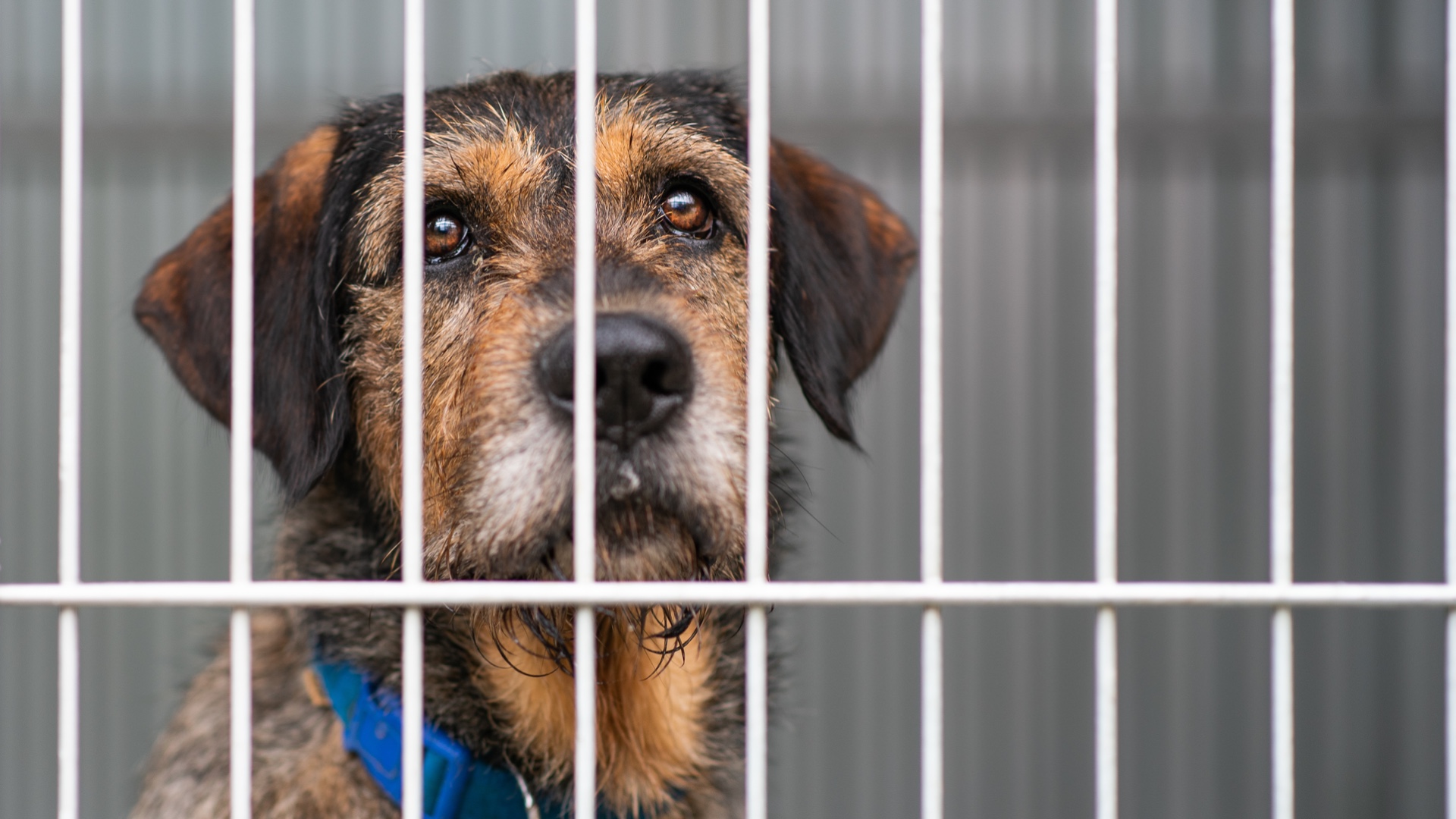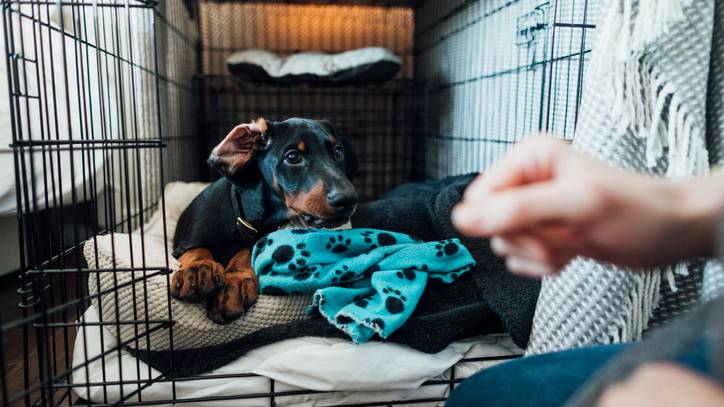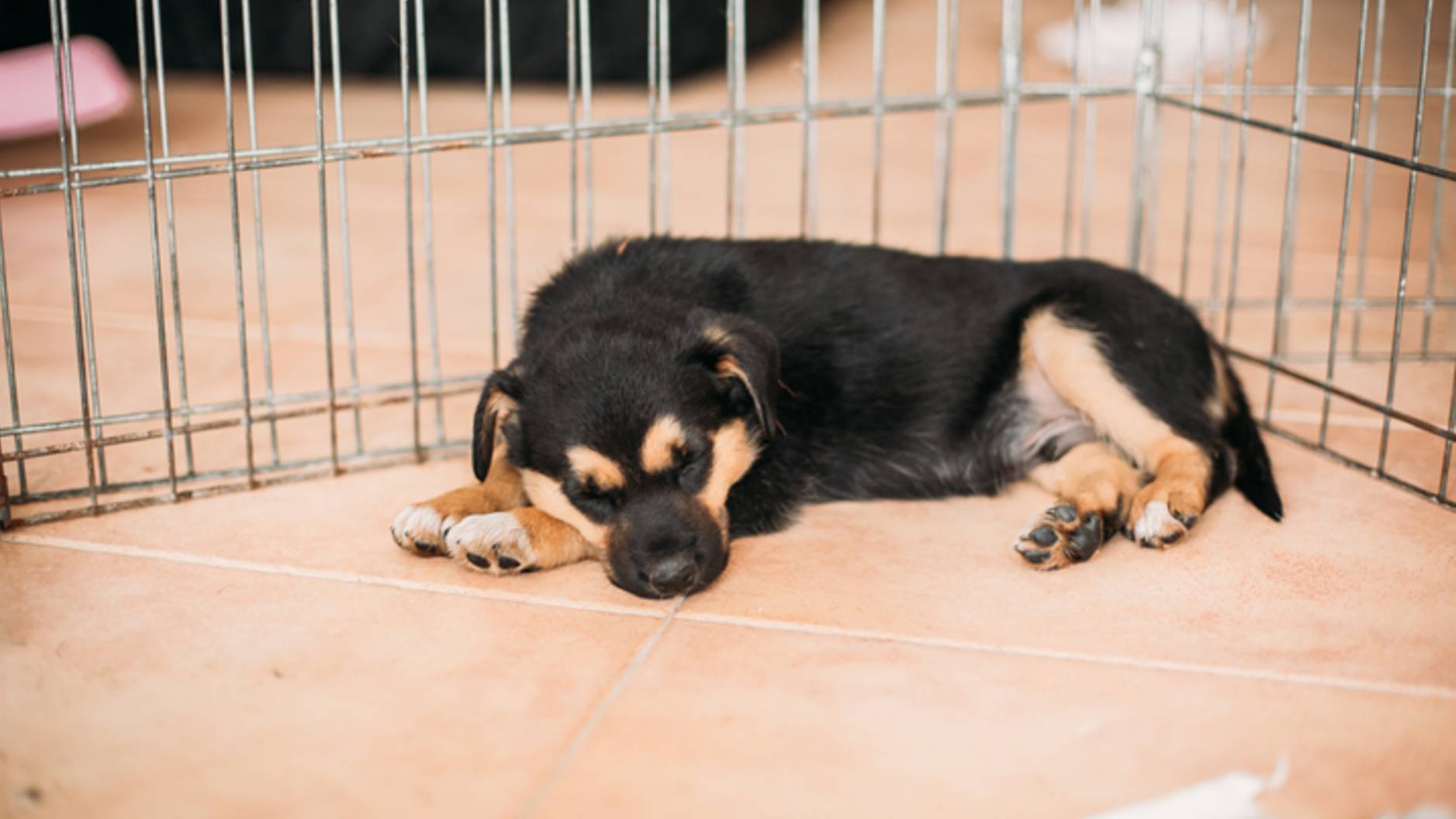How to stop a dog from barking in their crate
By discovering the root cause you can learn how to stop a dog from barking in their crate.

How to stop a dog from barking in their crate may well be a question that has you pulling your hair out. Dog crates are great investments and useful accessories to have, whether you use them at home, at work, or in the car but if your dog won’t settle in them and continues to make a load of noise whilst secured in their crate, then what do you do?
Barking, howling, whining and whimpering are all forms of doggie communication. Dogs can't tell you in words what they need or want you to know so being vocal is the next best tool for them to utilize. Even if you have the best dog crate, dogs can still be vocal for many reasons. It may be due to other dogs or animals’ being around, they may be frightened, hungry, sick or bored. There are numerous causes as to why they are expressing their energy or emotions in this way but regardless, the bottom line is they're trying to get your attention and tell you a message.
Crate training requires some skill, patience, consistency and persistence. It’s not always a walk-in-the-park experience for every pet parent but it is however still a completely doable part of dog ownership once you have all the right information. However, to relieve or rule out more simple issues, such as boredom or the munchies, trying some of the longest lasting dog chews can help soothe this predicament or you may wish to offer safe toys that you can leave in the crate with them to entertain and make them feel secure.
Beyond that, let’s investigate the possible reasons why they are barking in their crate and what you can do to stop it.
Why is my dog barking in their crate?
When you have a dog who’s constantly barking, howling, or whining every time they’re in their crate, it’s natural to want to jump straight into the solutions. But it can be worthwhile taking a moment to consider why they’re barking in the first place.
This could help you get to the root of the problem and potentially sort it out, rather than perpetuate it. Yes, they may just be crying for attention, but there could be other reasons.
1. They want out
Let's face it - if your dog has a choice between being shut in their crate and running free wherever you are, they're definitely going to choose the latter! Often, barking is simply their way of letting you know that they want out and and that they don't like being separated from you. Like a human baby that cries, barking is an attempt to get you to come back, this behavior is completely normal and is nothing to worry about.
2. They want to go to the toilet
There's no more desperate a situation for us humans than needing to go to the toilet and not being able to find one. Thankfully, we're usually able to hold it in until we're able to get to get to a restroom, but our canine companions aren't so fortunate. Imagine being stuck in a crate for eight hours when you're desperate to go do your business - not fun!
Dogs will often bark as a warning sign that they're in need of the toilet. You can help put a stop to this by ensuring you let them outside for a few minutes before you crate them as this will ensure their bladder is empty before you tuck them in.
3. They’re bored
A bored dog tends to be a loud dog and boredom can be a particular issue if you put your dog in their crate when they’re not tired. Exhausted dogs will tend to settle and fall asleep quickly, whereas dogs that are still alert need something to keep them occupied until sleepiness sets in. Popping a selection of dog toys in with your furry friend can help keep them entertained until they fall asleep.
4. They’re hungry
If you’re anything like us, there’s nothing worse than going to bed hungry! A rumbling tummy can keep anyone awake and it’s much the same for dogs. We recommend giving your dog a substantial meal around two hours before you crate them. It can also be worth popping one of the longest lasting dog chews in their crate with them to give them something to occupy themselves with.
5. They’ve sensed something unusual in their environment
Dogs can hear things we humans can't and because your canine companion feels fiercely protective of you and their home, barking is their way of alerting you to potential danger that may be going on inside or outside the home that you're not aware of.
When a dog is crated they’re not able to go and investigate in the way they normally would and so barking is their way of communicating that they’re picking up on something that’s out of the ordinary.
6. They don't like the location of their crate
Just us humans shopping for a home, when it comes to crate placement, it's all about location, location, location! Areas of the home that are very quiet, dark or damp - such as garages or basements - can leave your pup feeling particularly isolated and even scared. Try to set the crate up in a main area of the house that they're used to being in and that feels warm and inviting as this will help them to feel safe.

How can I stop my dog from barking in their crate?
Now that you're aware of the most common causes of your dog's barking when they're crated, it's time to shift gears and look at how you can put a stop to this unwelcome behavior. You'll find two common approaches to this below, as well as a range of additional helpful tips. Let's take a look...
1. The positive association method
The last thing you want is for your dog to associate their crate with some form of punishment. This will increase the likelihood of barking being an ongoing issue.
Instead, the positive association method teaches your furkid that good things happen in their crate, making it more likely that they'll want to spend time there. And the more they want to be there? The less they'll bark! Here are some ways to make crate times more enjoyable:
1. Make it cozy
First up, if you have one of the best dog beds, put it in your dog's crate. This will help make it a safe and snuggly space for them. A donut-style bed with high sides can be particularly comforting as these tend to mimic a mother's warmth and may help your pup to settle a little quicker. We also recommend furnishing it with a cozy blanket to make it even more inviting.
2. Add in some boredom busters
Let's face it, if you're not tired then the last thing you want is to be locked in a crate with nothing to do! As well as furnishing the crate with a bed and blanket, it’s also worth including one or two of the best dog toys to give your canine companion a buddy to play with and cuddle. This can help pass the time until they're feeling sleepy enough to doze off.
3. Hide a few treats
When your dog is elsewhere, hide a few of the best dog treats in and around their crate. Place a few under their blanket, in their bed, in a toy, and around the entrance. This will help entice your pup to want to go into their crate. KONG toys are also really useful as they can be stuffed with peanut butter or another dog paste that will help redirect your canine's attention and keep them amused.
4. Crated mealtimes
Another way to get your dog to associate their crate with positive things is to consider feeding them in their crate. You can start by doing this with the door open and then gradually work your way up to crating them with the door shut for around 10 minutes.
5. Gradual stays
It’s important to start slowly so that your dog has time to adjust to being in their crate. Begin by popping them in there for short bursts of around 15-30 minutes while you’re doing a task around the house, working your way up to longer periods if you’re needing to leave the home for a few hours.
6. Nightime crating
Your dog is far less likely to bark in their crate overnight if they’re in the same room as you, so if you’re comfortable doing so, bring their crate into your bedroom so that they know you’re there.
If you don’t want this being a permanent arrangement, wait until they’re sleeping through the night without barking and then slowly start to inch the crate out of your bedroom a little more each night until they’re in another room
2. The ignore method
The other option you have when it comes to getting your dog to stop barking in their crate is to use the ignore method. Here’s a step-by-step walkthrough of how to implement it to give you the best chance of success.
1. Don’t respond
It’s important to remember that every time you respond to your dog's barking with your attention, whether positive or negative, they will become conditioned to continue barking as a way to get their needs met. Barking is a behavior you don't want to reinforce, so as hard as it is, don't respond to them when they're acting out like this.
2. No talking
As well as not entering the room, you also want to avoid speaking to your dog from another room as hearing your voice will only encourage your pup to continue to bark.
3. Use music
Recent studies conducted on dogs at animal shelters found that playing relaxing music can put a stop to barking while also lowering respiratory rates and the stress hormone cortisol. Consider popping on some soothing music in the same room as your dog’s crate to help reduce anxiety.
4. Consider white noise
When your dog is crated they may be barking at sounds they can hear outside, in which case, white noise can be a great way of drowning out the sounds of voices and cars. Try running a fan or humidifier near their crate to give your dog a quieter space.
5. Try doggy pheromones
A holistic device that emits high-frequency sounds that help soothe stressed-out furkids can be another way to help keep your dog calm while they’re in their crate. We love the RelaxoPet Pro, but there are plenty of other great options on the market.
Do’s and don’ts

Alongside the above two methods, here are some additional do’s and don’ts that will help stop your dog from barking when they’re in their crate.
Don't let your dog out of their crate until they're quiet: In order to prevent positive reinforcement where barking gets them out of their crate, teach your dog that they will only be allowed out when they've stopped barking or crying.
Do consider your dog’s age and schedule: If your dog is a puppy, you’ll need to release them from their crate more frequently for toilet breaks than you would an adult dog. Also, avoid crating your dog when they haven’t been exercised or before they’ve been fed as restlessness and hunger will increase the likelihood of barking.
Don’t forget to give them a toilet break first: Always take your pup outside so that they have a chance to do their business before you put them in their crate.
Do feed them before crating them: Make sure your dog has been fed 1-2 hours before they go into their crate.
Don’t use the crate as a punishment: Never use the crate as a punishment for bad behavior. Remember, positively reinforcing and rewarding good behavior via praise and treats is far more effective.
Do tire them out: A tired dog is a sleepy dog, so make sure they’ve had plenty of exercise before they go into their crate.
Need to give your dog something safe for them to sink their teeth into? Discover a vet’s guide to safe dog chews for aggressive chewers. If your dog won't stop barking, this feature explains what to do.
PetsRadar Newsletter
Get the best advice, tips and top tech for your beloved Pets

Kathryn is a freelance writer who has been a member of the PetsRadar family since it launched in 2020. Highly experienced in her field, she's driven by a desire to provide pet parents with accurate, timely, and informative content that enables them to provide their fur friends with everything they need to thrive. Kathryn works closely with vets and trainers to ensure all articles offer the most up-to-date information across a range of pet-related fields, from insights into health and behavior issues to tips on products and training. When she’s not busy crafting the perfect sentence for her features, buying guides and news pieces, she can be found hanging out with her family (which includes one super sassy cat), drinking copious amounts of Jasmine tea and reading all the books.
